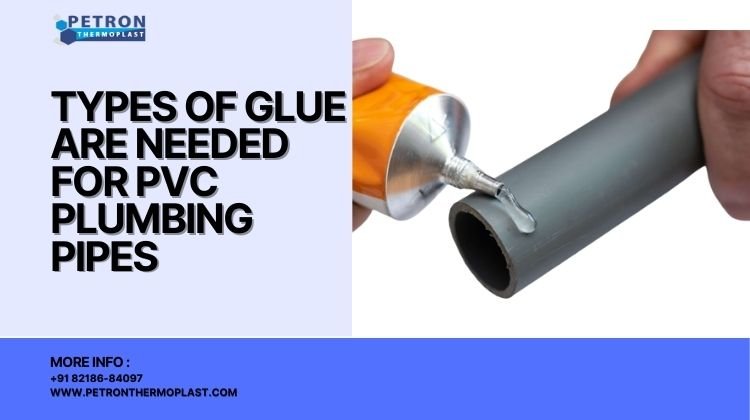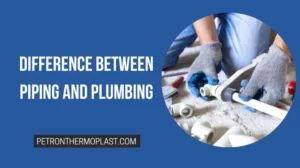As a homeowner, you may encounter situations where you need to connect PVC plumbing pipes. Whether you’re repairing a leak or installing new pipes, you’ll need the right type of glue to ensure a secure and long-lasting connection. In this blog post, we’ll discuss the types of glue are needed for PVC plumbing pipes and provide tips for making a strong bond.
Introduction
PVC plumbing pipes are commonly used in residential and commercial plumbing systems. These pipes are durable, affordable, and resistant to corrosion, making them a popular choice among homeowners and professionals. However, to make a strong connection between PVC pipes, you need the right type of glue.
Types of Glue are Needed for PVC Plumbing Pipes
There are several types of glue that can be used for PVC plumbing pipes. The most common ones are solvent-based glues and cement-based glues.
Solvent-based glues are also known as “pipe welding” or “pipe joining” glues. They work by melting the PVC pipes and fusing them together. Solvent-based glues are ideal for larger diameter pipes and joints that require a lot of pressure.
Cement-based glues are also known as “pipe cement” or “pipe adhesive.” They work by chemically bonding the PVC pipes together. Cement-based glues are ideal for smaller diameter pipes and joints that don’t require a lot of pressure.
Choosing the Right Glue
When choosing the right glue for PVC plumbing pipes, consider the size and type of pipes you are working with, as well as the application. For example, if you are repairing a leak in a small diameter pipe, a cement-based glue may be sufficient. However, if you are installing larger diameter pipes that will be under a lot of pressure, a solvent-based glue may be a better choice.
Steps: How to Use Glue for PVC Plumbing Pipes
When connecting PVC plumbing pipes, using the right type of glue is crucial to ensure a strong and long-lasting bond. Here are the steps to follow when using glue for PVC plumbing pipes:
Step 1: Clean the pipes
Before applying glue, it’s important to clean the surfaces of the pipes and fittings thoroughly. Use a PVC primer to remove any dirt, grease, or debris from the surfaces.
Step 2: Apply the glue
Apply the glue to both the pipe and fitting, making sure to spread it evenly over the surfaces. Be sure to apply enough glue to cover the entire joint.
Step 3: Join the pieces
Quickly join the two pieces together, making sure they are aligned correctly. The joint should be held firmly in place for at least 30 seconds to ensure a strong bond.
Step 4: Wipe off excess glue
Once the joint is in place, wipe off any excess glue that may have squeezed out of the joint. This will prevent it from hardening and causing obstructions in the plumbing system.
Step 5: Let the joint dry
Allow the joint to dry completely before using the plumbing system. The drying time can vary depending on the type of glue used and the environmental conditions. Refer to the manufacturer’s instructions for specific drying times.
By following these steps, you can ensure a secure and long-lasting connection between PVC plumbing pipes. Always use the appropriate type of glue for the job and take care to clean the surfaces thoroughly before applying glue.
PVC Diaphragm Valve and PVC Butterfly Valve
In addition to PVC plumbing pipes, PVC diaphragm valve and PVC butterfly valve are commonly used in plumbing systems. These valves require a different type of glue than PVC pipes. For PVC diaphragm valves, a solvent-based glue is recommended, while a cement-based glue is recommended for PVC butterfly valves.
Helpful Tips to Remember, While gluing the PVC Pipes
• Use PVC-specific primers and cement.
Using primers and cement that are specifically designed for PVC plumbing pipes will ensure a strong and reliable bond. These products are formulated to work together to create a chemical reaction that binds the pipes together securely.
• Cut the pipes straight and clean.
To ensure a tight fit and proper seal, it’s important to cut the PVC pipes straight and clean. Use a pipe cutter or saw to make a clean, straight cut at a 90-degree angle. Avoid using a serrated blade, which can leave jagged edges and compromise the seal.
• Apply primer and cement in a well-ventilated area.
The fumes from primer and cement can be strong and harmful if inhaled, so it’s important to work in a well-ventilated area. Open windows and doors or use a fan to circulate fresh air.
• Don’t over-apply primer and cement.
Using too much primer or cement can actually weaken the bond between the pipes. Apply a thin, even layer to both the pipe and fitting to ensure a tight seal without excess.
• Test the joint before using the plumbing system.
Before using the plumbing system, it’s a good idea to test the joint to ensure it’s secure. Fill the pipes with water and let them sit for a few hours to check for any leaks.
By following these helpful tips, you can ensure a successful and long-lasting connection between PVC plumbing pipes. Remember to use the right type of cement, work quickly, allow enough cure time, and take care to cut the pipes straight and clean.
Can You use Regular Glue for PVC pipe?
No, regular glue should not be used for PVC pipes. PVC pipes require a specific type of glue known as PVC cement, which is designed to create a strong and permanent bond between PVC pipes and fittings. Regular glue, such as super glue or epoxy, is not designed for use with PVC pipes and will not create a strong enough bond. Additionally, regular glue may not be able to withstand the pressure and stress placed on PVC pipes in plumbing and building applications, which could lead to leaks, cracks, or other issues. Therefore, it’s important to use the appropriate type of glue for PVC pipes, such as PVC cement, to ensure a secure and reliable connection.
Conclusion
In this blog we explained Types of Glue are Needed for PVC Plumbing Pipes. Choosing the right glue for PVC plumbing pipes is essential to ensure a strong and secure connection. Consider the size and type of pipes you are working with, as well as the application, when choosing the right type of glue. Always clean the surfaces thoroughly before applying glue and hold the pieces firmly in place for at least 30 seconds. By following these tips, you can make a lasting connection and avoid leaks in your plumbing system. If you like this blog please share with friends & social media channel.
FAQ
Q. What glue is used in PVC?
A. The glue used for PVC (polyvinyl chloride) is a solvent-based adhesive that contains tetrahydrofuran or methyl ethyl ketone. It creates a strong bond when applied to the PVC surfaces.
Q. Can CPVC glue be used on PVC pipe?
A. No, CPVC glue is specifically designed for use on chlorinated polyvinyl chloride (CPVC) pipes, and cannot be used on regular PVC pipes.
Q. What is the difference between PVC glue and PVC cement?
A. PVC glue and PVC cement are two different names for the same product. They are both used to bond PVC pipes and fittings together. The term “glue” is commonly used by DIY enthusiasts, while professionals often use the term “cement”. Both products work by chemically softening the surface of the PVC and then fusing it together. It is important to use a product specifically designed for PVC, as other types of glue or cement may not work effectively.
Q. Do you need primer to glue PVC?
A. Yes, using a primer before gluing PVC is recommended to ensure a strong bond. It helps clean and prepare the surface for the adhesive to bond properly.
Q. Will PVC glue stop a water leak?
A. PVC glue is not recommended for stopping water leaks. It is designed to bond pipes together, not to seal leaks. A proper sealant or patch should be used instead.
Read Also: Difference Between PVC Butterfly Valve and PVC Diaphragm Valve
Read Also: What is a Ball Valve
Read Also: Best Pipes for House Plumbing
Read Also: Difference Between PVC and Lead-Free PVC
Read Also: CPVC Pipes Preferred Nowadays



